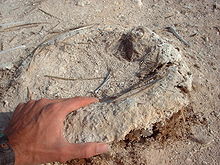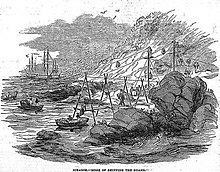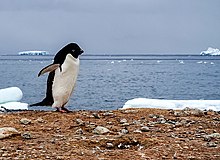guano



Guano is a fine-grained mixture of different phosphates such as the calcium hydrogen phosphates brushite and monetite , the calcium phosphate whitlockite as well as various apatites and nitrates and organic compounds. It arises from the pasty excrement of seabirds such as penguins or cormorants (see also guanocormorant ) by acting on limestone . Bat excrement is known as bat guano .
History and use
The Inca and other South American peoples already used guano to increase the yield in agriculture. When the Spaniards took over, the Indian peoples' knowledge of natural resources was lost, and it was not until the 18th century that bird droppings began to be used again as fertilizer. In 1806 Alexander von Humboldt brought the first guano samples with him to Europe, which he had chemists analyze. This later resulted in a guano boom, which lasted from 1845 to the end of the 19th century with a peak. Guano is used as a fertilizer containing nitrogen and phosphoric acid and is obtained mainly from the rain-poor coasts of South America . The word guano is derived from the Quechua language ( wanu ); it was borrowed into German via Spanish. According to Humboldt, guano goes back to Huanu , which in the Inca language means dung with which one fertilizes , whereby the Europeans would have confused Hua with Gua and u with o . Guano was used as a fertilizer in agriculture from the 19th century. In addition to natural nitrate , guano was also used to produce explosives .
“In our time, when so much attention is paid to the improvement of agriculture and so much effort is made to increase the fertility of the soil, the discovery of large deposits of a concentrated fertilizer, such as guano, is a fortunate event. Since we have so far only incomplete information on the location of the Guan camps, and since they are so peculiar and remarkable, I am sharing the description of such a site on a small African island where it was collected.
'The island from which this guano comes is located about three English miles from shore on the south-western coast of Africa. It is a barren rock about a (?) Mile in circumference, with no soil or the slightest trace of vegetation. The guano lies on it about twenty feet deep, with no difference in quality. The mainland is very sandy and, when the wind is strong, covers a ship's deck nearly 100 miles from land. The birds on this island are a kind of penguin (fat goose) and cannot fly the slightest distance because their wings are just a kind of flippers. It is believed that the captain of the ship that brought the guano was the first human being to step on this island, which is difficult to get to because there is no port and there is strong surf. When walking on this island he could hardly put his foot on without stepping on such birds, and they cared nothing about him except that they pecked him in the bare foot; when a rifle was fired they only fluttered strongly and made a great noise. It is believed that there is no fresh water for a few hundred miles along the coast. '"
In the middle of the 19th century, these two types of use made guano, along with sugar, rum, cotton, tobacco and indigo , one of the most important imported goods from the global economic periphery for the industrializing countries of Europe. In 1865 guano accounted for 1.0% of the import value of Great Britain, 0.6% of French imports, 1.5% of Belgian imports and 1.9% of the value of goods imported via Hamburg. The most important countries of origin were Peru, Chile / Bolivia, Pacific islands and West Africa. One of the largest importers in the second half of the 19th century up to the First World War was the Hamburg trading company Ohlendorff & Co.
In 1908 the German chemist Fritz Haber succeeded in synthetically producing ammonia from hydrogen and nitrogen , for which he received the patent ( Haber-Bosch process ) in 1910 and the Nobel Prize in Chemistry in 1918 ; In doing so, he secured not only the production of artificial fertilizers, but also the munitions production for Germany during the First World War . The introduction of the Haber-Bosch process meant a drastic reduction in the need for guano.
Origin and ingredients
Guanine excreted by birds or bats (mixed with uric acid) forms guano through weathering, especially on calcareous soils.
In 1896, the zoologist Hugo Schauinsland examined the formation of guano on the Hawaiian island of Laysan under rainy conditions. Here, the bird droppings are leached out, the water soaked with it seeps into the depths and impregnates the lime sands there. In particular, phosphoric acid limes and hard rock guano are formed . An analysis showed proportions of 11.5% P 2 O 5 and 48.6% CaO for the brown surface guano, and 36.9% P 2 O 5 and 33.3% CaO for the light rock guano . The raw Laysan guano mined at that time contained an average of 25-30% phosphoric acid. In addition, guano typically contains 7–8%, rarely up to 60% nitrates as potassium nitrate ( potash nitrate ) or sodium nitrate ( Chile nitrate ).
On islands with large numbers of birds, the guano layer can become very thick, which is what makes the economic exploitation of bird remains possible in the first place. Within one year, for example, 300,000 tons of guano were collected on the 6.5 hectare island of Ichaboe ( Namibia ) and shipped to Great Britain . The crew of the British ship Grace found a position of "30 to 40 feet" of guano on Ichaboe Island in 1844. This corresponds to about 9 to 12 meters.
The island of Nauru owed its temporary wealth to the mining of large phosphate deposits (up to 90% pure). The origin of the phosphorite , called nauruit , has not been clarified beyond doubt, but it probably goes back to guano in connection with reef limestone. Phosphate mining was the island's main source of income until 2000.
Others
- A great deal of guano was mined on the penguin islands of Namibia from the 1840s to the 1930s. Since then, this has been dismantled on an artificial platform, Bird Island .
- The Humboldt penguin digs its nest hole in guano slopes and is increasingly threatened by the disappearance of the guano deposits due to overexploitation .
- The last cargo sailors that sailed around Cape Horn (the famous " Kaphoorniers ") transported guano and saltpetre from the Pacific to Europe, because this cargo was not in a hurry and so the expensive fees for using the Panama Canal could be saved.
- Joseph Victor von Scheffel referred to guano in his eponymous mockery poem to express his criticism of Hegel.
- A German rock band goes by the name of Guano Apes .
- Dr. No from the novel James Bond is chasing Dr. No by Ian Fleming deals with guano. All his wealth goes back to the trade in guano, which he mines on his private island Crab Key.
- Ammonia from the guano of millions of birds promotes cloud formation and has a measurable cooling effect on the arctic climate.
Related topics
- Natural guano made the profession of nitric boiler obsolete.
- Guano Islands Act is a US law according to which any island that neither belongs to nor is inhabited by citizens of another nation can be made US state territory by US presidents if a US citizen discovers guano there and takes possession of the island with peaceful intent. Over fifty islands were temporarily incorporated into American territory in this way.
literature
- G. Hth .: The guano and its localities . In: The Gazebo . Issue 17, 1863, pp. 260-264 ( full text [ Wikisource ]).
- Bärbel Rott: Alexander von Humboldt brought guano to Europe - with unexpected global consequences In: Humboldt im Netz , Volume 17, No. 32 (2016).
Web links
Individual evidence
- ↑ Martin Okrusch, Siegfried Matthes: Mineralogie. An introduction to special mineralogy, petrology and geology . 7th fully revised and updated edition. Springer Verlag, Berlin and others 2005, ISBN 3-540-23812-3 , pp. 305 .
- ↑ Bärbel Rott: Alexander von Humboldt brought guano to Europe - with unexpected global consequences In: Humboldt im Netz Volume 17, No. 32 (2016).
- ↑ On the composition of guano. In: Annalen der Pharmacie / Annalen der Chemie und Pharmacie , year 1841, p. 315 (online at ANNO ).
- ↑ John Davy : About the South American and African Guano. In: Polytechnisches Journal , year 1844, p. 300 (online at ANNO ).
- ^ H. Schauinsland: Three months on a coral island (Laysan). Bremen 1899.
- ^ Ichaboe - Mode of Shipping the Guano. ( Memento of September 30, 2007 in the Internet Archive ) National Maritime Museum
- ^ B. Croft, GR Wentworth, RV Martin, WR Leaitch, JG Murphy: Contribution of Arctic seabird-colony ammonia to atmospheric particles and cloud-albedo radiative effect . In: Nature Communications . tape 7 , November 15, 2016, ISSN 2041-1723 , doi : 10.1038 / ncomms13444 ( nature.com [accessed November 18, 2016]).


